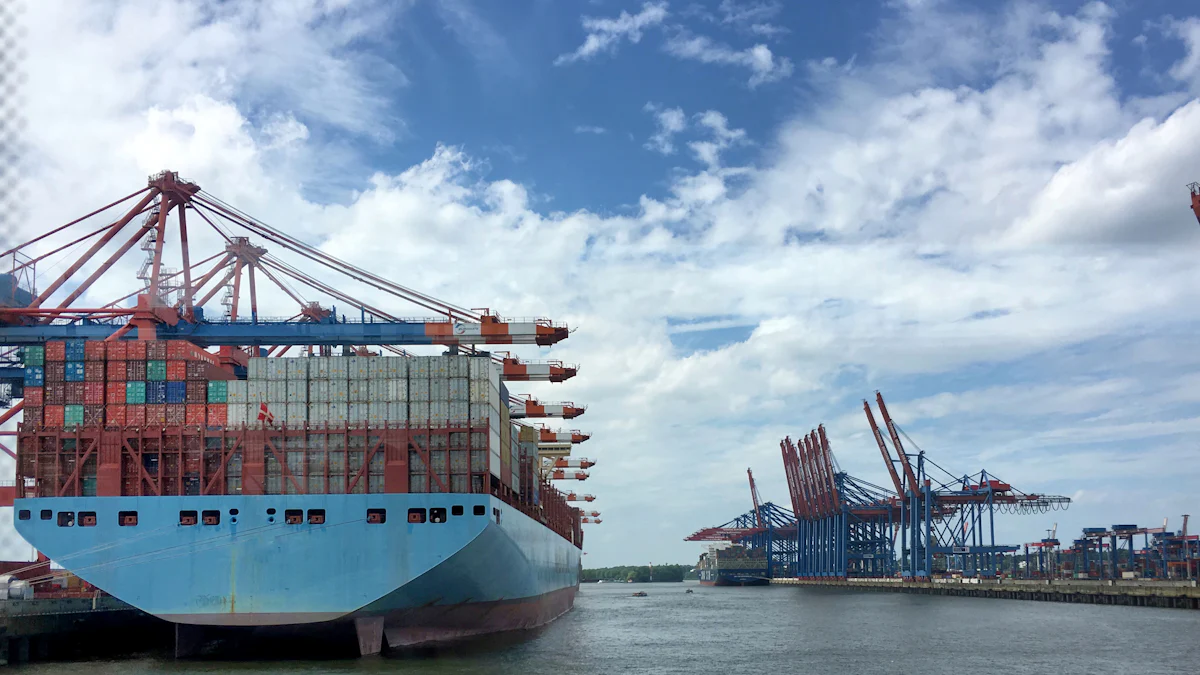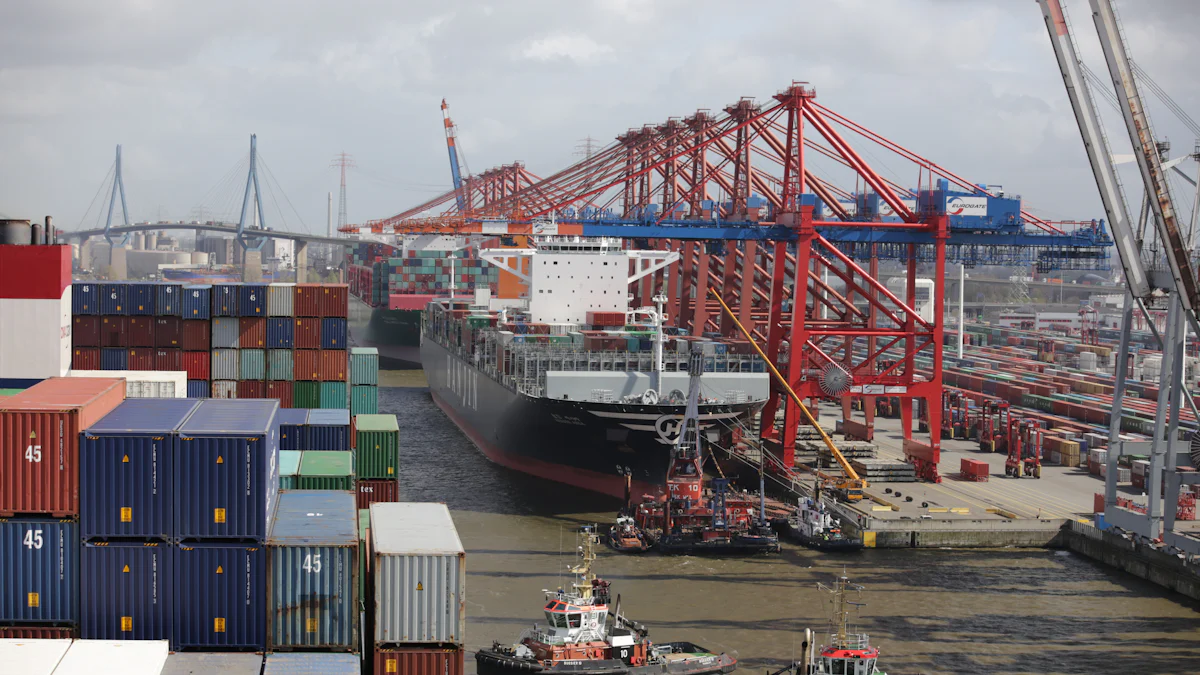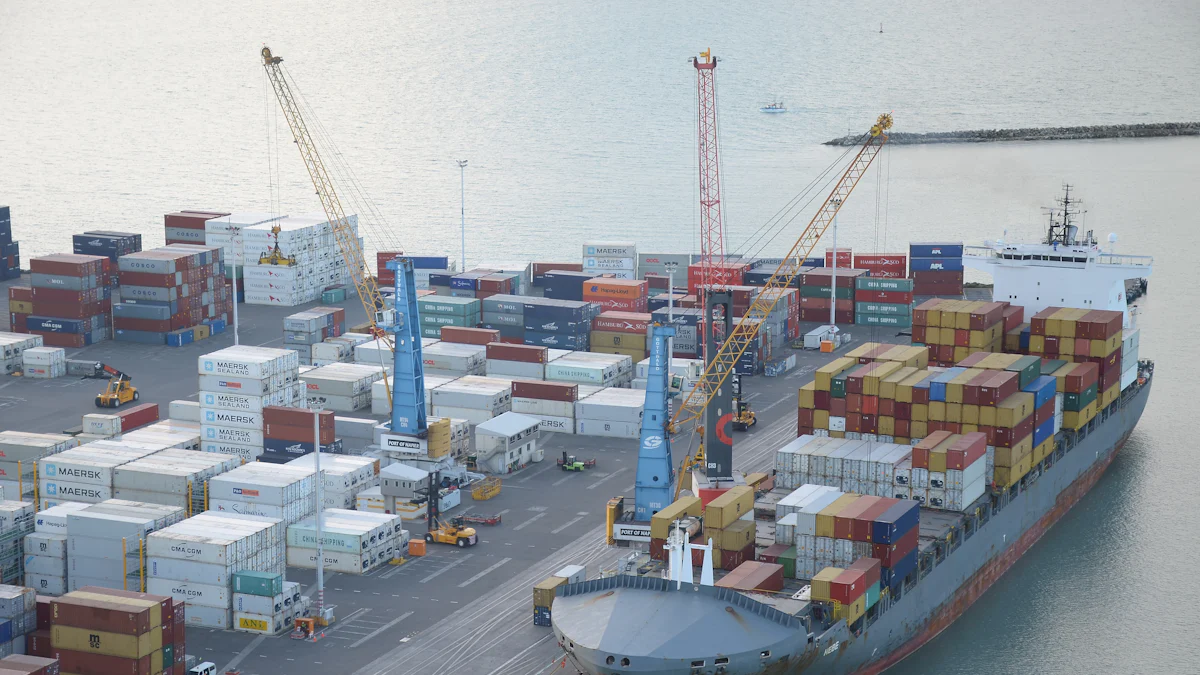How to Track and Monitor Ocean Freight Effectively

Ocean freight plays a pivotal role in global trade, handling nearly 90% of international shipments. Its cost-effectiveness and environmental advantages make it indispensable for transporting large volumes of goods. However, without robust ocean freight visibility, inefficiencies and risks can disrupt operations. Reliable tracking ensures smooth supply chain management by providing real-time updates and actionable insights. As an essential part of international ocean freight, visibility empowers you to anticipate delays, manage risks, and maintain operational efficiency. By leveraging advanced tools, you can transform your supply chain visibility into a competitive advantage.
Tools and Technologies for Ocean Freight Tracking

Efficient tracking of ocean freight requires the use of advanced tools and technologies. These solutions provide you with the ability to monitor shipments, anticipate potential disruptions, and optimize your supply chain operations.
GPS and Satellite Monitoring Systems
GPS and satellite monitoring systems form the backbone of modern ocean freight tracking. These technologies allow you to pinpoint the exact location of your shipments at any given time. By leveraging satellite communication, you gain access to real-time tracking data, which ensures you stay informed about the progress of your cargo. This level of visibility helps you plan better and respond proactively to delays or route deviations.
For instance, GPS-enabled tracking systems provide precise location updates, enabling you to monitor your shipments throughout their journey. This technology is particularly useful for long-haul ocean freight, where maintaining visibility across vast distances is critical.
Internet of Things (IoT) for Real-Time Updates
The Internet of Things (IoT) has revolutionized how you track and monitor ocean freight. IoT devices, such as smart sensors, can be attached to containers to provide real-time updates on various parameters, including location, temperature, and humidity. These insights are invaluable for industries like pharmaceuticals and food, where maintaining specific conditions during transit is essential, and can enhance ocean freight tracking.
IoT-enabled tracking not only enhances visibility but also allows you to identify potential risks before they escalate. For example, if a sensor detects a temperature fluctuation, you can take immediate action to prevent damage to your goods. This proactive approach minimizes losses and ensures the quality of your shipments.
Freight Visibility Platforms for Centralized Data
Freight visibility platforms consolidate all tracking data into a single, user-friendly interface. These platforms provide you with actionable insights by integrating data from multiple sources, such as GPS, IoT devices, and carrier systems. With centralized data, you can monitor your shipments more effectively and make informed decisions to optimize your operations.
A robust freight visibility platform not only tracks the location of your cargo but also offers enhanced features like live ETAs, terminal visibility, and customs data. These capabilities empower you to manage your shipments with greater precision and confidence.
By adopting these tools and technologies, you can transform your ocean freight tracking process into a seamless and efficient operation. These solutions not only improve visibility but also help you stay competitive in the ever-evolving logistics landscape.
Integration with Transportation Management Systems (TMS)
Integrating ocean freight tracking with Transportation Management Systems (TMS) enhances your ability to manage shipments efficiently. TMS serves as a centralized platform that consolidates all logistics data, enabling you to streamline operations and improve decision-making. By combining TMS with advanced tracking technologies, you gain a comprehensive view of your supply chain.
A well-integrated TMS allows you to monitor shipments in real time, optimize routes, and reduce transit times. This integration ensures that you can respond promptly to unexpected disruptions, such as delays or route changes.
Key Benefits of TMS Integration:
Real-Time Visibility: TMS integration provides live updates on shipment locations and statuses. This feature ensures you stay informed throughout the logistics journey.
Enhanced Efficiency: By automating processes like route planning and scheduling, TMS reduces manual effort and minimizes errors.
Data-Driven Insights: TMS collects and analyzes data from multiple sources, offering actionable insights to optimize your supply chain performance.
Seamless Communication: Integration fosters better collaboration between shippers, carriers, and other stakeholders by centralizing communication.
For example, pairing TMS with ocean container tracking solutions allows you to access enriched data, such as terminal visibility, vessel verification, and live ETAs. These features empower you to make proactive decisions and maintain control over your shipments.
According to industry experts, leveraging TMS alongside ocean freight visibility platforms not only improves operational efficiency but also enhances customer satisfaction by providing accurate delivery timelines.
Adopting TMS integration ensures that your ocean freight tracking aligns with modern logistics demands. This approach equips you with the tools needed to navigate complexities, reduce costs, and maintain a competitive edge in the global market.
Best Practices for Monitoring Ocean Freight Shipments
Monitoring ocean freight effectively requires a strategic approach. By adopting proven practices, you can enhance visibility, minimize risks, and ensure smooth operations. Below are key practices to help you optimize your ocean freight management.
Selecting the Right Tracking Solutions
Choosing the right tracking solutions is essential for maintaining control over your shipments.
For example, Uber Freight TMS offers real-time tracking that gives you full visibility and control over your shipment’s journey. This system integrates with carrier networks, enabling precise tracking and timely updates.
When evaluating tracking solutions, prioritize features such as multi-modal tracking, ERP integration, and document archiving. These capabilities simplify freight management and support informed decision-making. Tools like ViewPoint TMS go beyond standard systems by offering flexible insights and seamless integration with carrier networks.
To ensure success, align your tracking solutions with your specific shipping needs. Whether you require temperature monitoring for sensitive goods or live ETAs for time-critical shipments, selecting the right tools will significantly improve your ocean freight visibility.
Partnering with Reliable Freight Forwarders
Collaborating with dependable freight forwarders is another critical step in monitoring ocean freight shipments.
A trustworthy freight forwarder provides consistent updates on shipment status, helping you maintain supply chain visibility. They also handle complex logistics tasks, such as customs clearance and route optimization, reducing the burden on your team.
According to industry experts, partnering with experienced freight forwarders enhances operational efficiency and minimizes risks. Their established relationships with carriers and ports streamline the shipping process, ensuring timely deliveries.
When selecting a freight forwarder, evaluate their track record, technology adoption, and customer service. A forwarder equipped with modern tracking tools and a proactive approach will help you stay ahead in the competitive logistics landscape.
Maintaining Accurate Documentation and Records
Accurate documentation is the backbone of effective ocean freight management. Proper records ensure compliance with international regulations, reduce delays, and facilitate smooth communication between stakeholders.
Key documents to maintain include:
Bill of Lading (BOL): Serves as proof of shipment and outlines the terms of transport.
Commercial Invoice: Details the value and description of goods for customs purposes.
Packing List: Provides a detailed breakdown of the shipment’s contents.
Customs Documentation: Ensures compliance with import/export regulations.
Digital tools like ViewPoint TMS simplify document management by offering extended archiving and easy access to critical records. By digitizing your documentation process, you can reduce errors, save time, and improve overall efficiency.
For instance, integrating document management with your tracking system allows you to access shipment details and compliance records in one place. This streamlined approach supports better decision-making and enhances your ocean freight visibility.
Regularly auditing your records ensures accuracy and compliance. By maintaining organized and up-to-date documentation, you can avoid costly errors and keep your shipments on track.
Setting Up Automated Alerts for Key Milestones
Automated alerts play a crucial role in ensuring you stay informed about your ocean freight shipments. These alerts notify you of key milestones, such as departure, arrival at ports, customs clearance, and final delivery. By setting up automated notifications, you can proactively manage your shipments and address potential issues before they escalate.
Modern shipping solutions like Uber Freight TMS and ViewPoint TMS offer robust alert systems that provide real-time updates. These systems allow you to customize notifications based on your specific needs. For instance, you can receive alerts when your shipment departs from the origin port or when it encounters delays during transit. This level of visibility ensures you remain in control of your supply chain at all times.
According to logistics experts, automated alerts reduce the risk of missed updates and improve communication between shippers and carriers. They also enhance customer satisfaction by providing accurate delivery timelines.
To set up effective alerts, follow these steps:
Identify Key Milestones: Determine the critical stages of your shipment journey that require monitoring. Common milestones include container loading, vessel departure, customs clearance, and final delivery.
Choose a Reliable System: Select a tracking platform that supports automated notifications. Tools like Uber Freight TMS integrate seamlessly with carrier networks, ensuring precise and timely alerts.
Customize Notification Preferences: Tailor alerts to suit your operational needs. For example, you can opt for email or SMS notifications for urgent updates.
Test and Monitor Alerts: Regularly test the alert system to ensure accuracy. Monitor the performance of notifications to identify any gaps or delays.
By implementing automated alerts, you can streamline your freight management process. These alerts not only keep you informed but also enable you to make data-driven decisions. For example, if an alert indicates a delay at a port, you can immediately coordinate with your freight forwarder to explore alternative solutions.
Advanced shipping solutions like ViewPoint TMS go beyond basic notifications. They offer multi-modal tracking and ERP integration, which provide a comprehensive view of your supply chain. With these features, you can access real-time insights and maintain seamless communication with all stakeholders.
Automated alerts are essential for modern logistics. They help you anticipate challenges, improve operational efficiency, and ensure timely deliveries. By leveraging these tools, you can enhance your ocean freight visibility and stay ahead in the competitive shipping industry.
Future Trends in Ocean Freight Monitoring

The logistics industry continues to evolve, and ocean freight monitoring is no exception. Emerging technologies are reshaping how you track and manage shipments, offering innovative solutions to enhance efficiency, transparency, and reliability. Below are some of the most promising trends that will define the future of ocean freight monitoring.
Artificial Intelligence for Predictive Analytics
Artificial Intelligence (AI) is revolutionizing ocean freight by enabling predictive analytics. AI-powered systems analyze vast amounts of data to forecast potential disruptions, such as weather conditions, port congestion, or equipment failures. These insights allow you to make proactive decisions and minimize risks.
For example, AI algorithms can predict delays based on historical data and real-time updates. This capability helps you optimize routes and adjust schedules to ensure timely deliveries.
AI also enhances demand forecasting. By analyzing market trends and shipping patterns, AI tools help you anticipate fluctuations in demand and allocate resources more effectively. This level of precision reduces costs and improves operational efficiency.
Key Benefits of AI in Freight Monitoring:
Proactive Risk Management: Identify potential issues before they escalate.
Enhanced Decision-Making: Use data-driven insights to optimize operations.
Cost Savings: Reduce inefficiencies and improve resource allocation.
Adopting AI-driven solutions equips you with the tools needed to stay competitive in a rapidly changing logistics landscape.
Blockchain for Transparent and Secure Tracking
Blockchain technology is transforming ocean freight monitoring by providing a transparent and secure way to track shipments.
According to industry experts, blockchain enhances trust among stakeholders by offering a tamper-proof record of shipment activities. This transparency simplifies dispute resolution and strengthens partnerships.
Blockchain also streamlines documentation processes. Smart contracts, a feature of blockchain, automate tasks like payment releases and customs clearance. These contracts execute automatically when predefined conditions are met, reducing delays and manual errors.
Applications of Blockchain in Freight Monitoring:
Secure Data Sharing: Share shipment information with stakeholders without compromising security.
Real-Time Updates: Access accurate and up-to-date tracking information.
Automated Processes: Use smart contracts to simplify complex logistics tasks.
By integrating blockchain into your freight monitoring systems, you can enhance transparency, improve efficiency, and build stronger relationships with partners and customers.
Automation and Smart Contracts in Logistics
Automation is redefining logistics by streamlining operations and reducing manual intervention. Automated systems handle repetitive tasks, such as data entry, scheduling, and route optimization, allowing you to focus on strategic activities.
Smart contracts, powered by blockchain, take automation to the next level. These self-executing contracts trigger actions based on predefined conditions. For instance, a smart contract can release payment to a carrier once a shipment reaches its destination.
Tools like GoFreight Real-Time Tracking and Sea Cargo Tracking Tool already incorporate automation features. These systems provide automated notifications for key milestones, such as departure, arrival, and customs clearance. This functionality keeps you informed and enables proactive planning.
Advantages of Automation and Smart Contracts:
Increased Efficiency: Automate routine tasks to save time and reduce errors.
Improved Accuracy: Minimize human errors in documentation and tracking.
Faster Transactions: Use smart contracts to expedite payments and approvals.
Automation and smart contracts not only enhance operational efficiency but also improve customer satisfaction by ensuring timely and accurate deliveries.
The future of ocean freight monitoring lies in adopting these cutting-edge technologies. By leveraging AI, blockchain, and automation, you can transform your logistics operations, reduce risks, and stay ahead in the competitive shipping industry.
Renewable Energy Integration
Renewable energy sources, such as wind and solar power, are gaining traction in ocean freight. Some vessels now feature solar panels or wind-assisted propulsion systems to supplement traditional energy sources. These technologies reduce reliance on fossil fuels and cut operational costs.
A growing number of shipping companies are experimenting with wind-assisted technologies, such as rotor sails, which harness wind energy to propel vessels. This approach can reduce fuel consumption by up to 10%, making it a viable option for sustainable shipping.
By supporting carriers that integrate renewable energy, you can further your sustainability efforts and reduce your carbon footprint.
Digital Solutions for Emission Monitoring
Digital tools play a vital role in tracking and reducing emissions. Platforms like GoFreight Real-Time Tracking and Sea Cargo Tracking Tool provide comprehensive insights into shipment data, enabling you to monitor fuel consumption and emissions. These tools help you identify inefficiencies and implement corrective measures.
For instance, real-time tracking systems generate automatic alerts and notifications, allowing you to respond proactively to potential inefficiencies. This capability ensures that your operations remain both cost-effective and environmentally friendly.
By leveraging digital solutions, you can optimize your shipping routes, reduce idle times, and minimize unnecessary fuel consumption.
The Benefits of Green Shipping Technologies
Adopting green shipping technologies offers several advantages:
Regulatory Compliance: Meet international environmental standards and avoid penalties.
Cost Savings: Reduce fuel consumption and operational expenses.
Enhanced Reputation: Appeal to eco-conscious customers and stakeholders.
Risk Mitigation: Stay ahead of evolving regulations and market demands.
Sustainability is no longer optional in the logistics industry. By embracing green shipping technologies, you can position your business as a leader in environmental responsibility while improving operational efficiency.
Ocean freight visibility plays a vital role in optimizing your supply chain operations and reducing risks. By adopting advanced tools like GPS tracking, IoT devices, and freight visibility platforms, you can gain real-time insights into your shipments and make proactive decisions. Implementing best practices, such as partnering with reliable freight forwarders and maintaining accurate documentation, ensures seamless ocean freight management. Staying competitive in today’s logistics landscape requires leveraging these strategies to enhance efficiency and reliability. Take action now to transform your supply chain visibility into a powerful advantage.
See Also
Exploring Innovations in Sea Freight Logistics for 2024
The Benefits of Joining These Leading Logistics Webinars
Understanding Current Trends in Logistics Risk Management
Enhancing Efficiency Through JUSDA's Complete Supply Chain Insights
